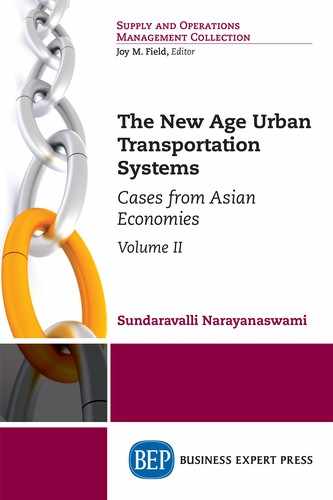Urbanization is the most common global phenomenon in recent times which brings upon huge stress in the existing infrastructure and transportation systems in cities. Interestingly, urban (transportation) challenges are more significant in developing countries and specifically in fast growing Asian countries. This is due to the fact that land occupation is very dense and social aspirations for growth (and therefore demand for mobility) are much higher in developing countries than in developed countries. Limited urban space and infrastructure fail to meet the rapid and huge demands in traffic volume and better quality of services. Therefore the need for design, development, operations and regulation of modern urban transportation systems is more intense than ever.
Infrastructural development and transportation operations are mainly directed at citizen welfare, and they require huge capital investments. Therefore, in many countries urban transportation projects are initiated and executed by the states. Mostly, states opt for private participation so as to minimize the risks in terms of project design, time planning, consortia participation and quality of execution. This brings a very interesting caveat to the domain. Per se, there are several commonalities in the planning and management of urban transportation projects across the globe. But the approach and solutions have to be developed specific to a local context and relevance. Urban transportation as a domain, is multi-disciplinary, interdependencies between the components are complex and repeatability (and inter-operability) of developed models or solutions is near impossible. Specific challenges include land use planning based on socio-economic distribution, project designing, implementation, financial analysis, governmental decisions that involve several stakeholders with varied capabilities and roles.
We comprehensively cover the domain background, challenges involved in developing such large scale, capital intensive projects of long gestation period and various approaches adopted by different countries. The discussions are presented through five real-life cases on modern urban transportation systems from Asian countries, as an illustration of what works and what does not in a particular context. The cities that are covered in the text are Delhi, Ahmedabad, Pune, Singapore, and Yichang. The text is organized as two volumes; the cases on Delhi, Ahmedabad, and Pune are covered in Volume I and those of Singapore and Yichang are covered in Volume II. The introduction chapter discusses the background of urban transportation planning, specifically related to Asian countries and the challenges involved. This is followed up with a detailed coverage of modern transportation systems in the five Asian cities, each presented as a chapter. The conclusion chapter summarizes the discussion. Brief comparison of the transport systems in five cities along with the interpre-tations and insights are presented.
